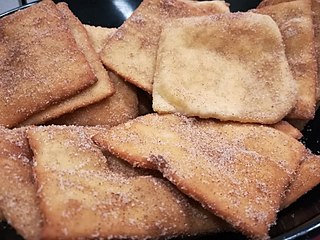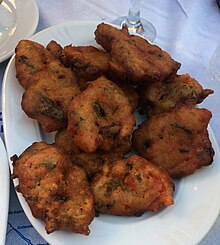
Greek cuisine is the cuisine of Greece and the Greek diaspora. In common with many other cuisines of the Mediterranean, it is founded on the triad of wheat, olive oil, and wine. It uses vegetables, olive oil, grains, fish, and meat, including pork, poultry, veal and beef, lamb, rabbit, and goat. Other important ingredients include pasta, cheeses, herbs, lemon juice, olives and olive oil, and yogurt. Bread made of wheat is ubiquitous; other grains, notably barley, are also used, especially for paximathia. Common dessert ingredients include nuts, honey, fruits, sesame, and filo pastries. It continues traditions from Ancient Greek and Byzantine cuisine, while incorporating Asian, Turkish, Balkan, and Italian influences.

Cooking bananas are a group of banana cultivars in the genus Musa whose fruits are generally used in cooking. They are not eaten raw and are generally starchy. Many cooking bananas are referred to as plantains or 'green bananas'. In botanical usage, the term "plantain" is used only for true plantains, while other starchy cultivars used for cooking are called "cooking bananas". True plantains are cooking cultivars belonging to the AAB group, while cooking bananas are any cooking cultivar belonging to the AAB, AAA, ABB, or BBB groups. The currently accepted scientific name for all such cultivars in these groups is Musa × paradisiaca. Fe'i bananas from the Pacific Islands are often eaten roasted or boiled, and are thus informally referred to as "mountain plantains", but they do not belong to any of the species from which all modern banana cultivars are descended.

Trinidad and Tobago cuisine is influenced by Indian-South Asian, West African, Creole, European, American, Chinese, Amerindian, and Latin American culinary styles.

Pakora is a fritter originating from the Indian subcontinent. They are sold by street vendors and served in restaurants across South Asia. They often consist of vegetables such as potatoes and onions, which are coated in seasoned gram flour batter and deep-fried.

A fritter is a portion of meat, seafood, fruit, vegetables, or other ingredients which have been battered or breaded, or just a portion of dough without further ingredients, that is deep-fried. Fritters are prepared in both sweet and savory varieties.

A sopaipilla, sopapilla, sopaipa, or cachanga is a kind of fried pastry and a type of quick bread served in several regions with Spanish heritage in the Americas. The word sopaipilla is the diminutive of sopaipa, a word that entered Spanish from the Mozarabic language of Al-Andalus. The original Mozarabic word Xopaipa was used to mean bread soaked in oil. The word is derived in turn from the Germanic word suppa, which meant bread soaked in liquid.

A hushpuppy is a small, savory, deep-fried round ball made from cornmeal-based batter. Hushpuppies are frequently served as a side dish with seafood and other deep-fried foods.

Iraqi cuisine is a Middle Eastern cuisine that has its origins in the ancient Near East culture of the fertile crescent. Tablets found in ancient ruins in Iraq show recipes prepared in the temples during religious festivals—the first cookbooks in the world. Ancient Iraq's cultural sophistication extended to the culinary arts.

Levantine cuisine is the traditional cuisine of the Levant, in the sense of the rough area of former Ottoman Syria. The cuisine has similarities with Egyptian cuisine, North African cuisine and Ottoman cuisine. It is particularly known for its meze spreads of hot and cold dishes, most notably among them ful medames, hummus, tabbouleh and baba ghanoush, accompanied by bread.

A buñuelo (Spanish:[buˈɲwelo], alternatively called boñuelo, bimuelo, birmuelo, bermuelo, bumuelo, burmuelo, or bonuelo, is a fried dough fritter found in Spain, Latin America, and other regions with a historical connection to Spaniards, including Southwest Europe, the Balkans, Anatolia, and other parts of Asia and North Africa. Buñuelos are traditionally prepared at Christmas. It will usually have a filling or a topping. In Mexican cuisine, it is often served with a syrup made with piloncillo.
Green bananas are unripe bananas used in cuisines worldwide. They have a firmer texture and a starchy, mildly astringent taste compared to their ripe counterparts.

Ghanaian cuisine refers to the meals of the Ghanaian people. The main dishes of Ghana are centered around starchy staple foods, accompanied by either a sauce or soup as well as a source of protein. The primary ingredients for the vast majority of soups and stews are tomatoes, hot peppers, and onions. As a result of these main ingredients, most Ghanaian jollof rice, soups, and stews appear red or orange.

An oliebol is a Dutch beignet, a variety of doughnut or fried dough that is traditionally eaten on New Year's Eve. People often eat it with raisins baked inside and with powdered sugar on top. Another variation is made with apple inside instead of raisins. There are similar foods all around the world, for example Samoan Panikeke, eaten mostly with jam or butter on top.

Corn fritters are fried cakes of a dough or batter made of, or containing a featured quantity of maize (corn). Originating in Native American cuisine, they are a traditional sweet and savory snack in the Southern United States, as well as Indonesia where they are known as perkedel jagung or bakwan jagung.

Mücver is a Turkish fritter or pancake, made from grated zucchini (courgette). They are typically pan-fried in oil and their batter often includes a mixture of eggs, onion, dill, parsley, flour, and sometimes potatoes and cheese. They are similar to Jewish latkes and potato pancakes from various cultures.

The traditional cuisine of Abruzzo is eclectic, drawing on pastoral, mountain, and coastal cuisine. Staples of Abruzzo cuisine include bread, pasta, meat, fish, cheese, and wine. The isolation which has characterized the region for centuries has ensured the independence of its culinary tradition from those of nearby regions. Local cuisine was widely appreciated in a 2013 survey among foreign tourists.

Okoy or ukoy, are Filipino crispy deep-fried fritters made with glutinous rice batter, unshelled small shrimp, and various vegetables, including calabaza, sweet potato, cassava, mung bean sprouts, scallions and julienned carrots, onions, and green papaya. They are traditionally served with vinegar-based dipping sauces. They are eaten on their own or with white rice. They are popular for breakfast, snacks, or appetizers. Okoy are sometimes dyed bright orange with achuete seeds.
Domates mücveri are fried tomato balls served as an appetizer on the Turkey. The dish is made from crushed or pureed tomatoes fried in oil. The batter is tomatoes and flour kneaded into a dough along with spices, parsley, onion, and mint; the dough is then fried in cooking oil and served as an appetizer.
















